
The Project
I was brought into this healthcare provider to help with the offboarding process for members wanting to cancel their private health insurance policies. Drivers for wanting to improve the offboarding process for their members was for three main reasons.
- Members have a positive last impression so they have a higher proposensity to come back
- Commercial, it was costing the provider 100's of thousands of dollars in unprocessed ITCs
- Regulatory, Abiding by Royal Commission recommendations on how to treat customers wanting to leave
The business goals for improving the offboarding process were to...
- Save as many members as possible with a positive experience
- Reduce the amount of complaints about the cancellation process
- Save members by having a conversation
Workshop
There were two outcomes we wanted to achieve by running this alignment workshop, they were:
- Getting key stakeholders to understand what empathy is and what that means for their members
- Go through each of the touchpoint journeys and understand the pain points for each one
Understanding empathy
At the start of the workshop we wanted the key stakeholders to understand empathy and how we can design experiences from the member's point of view rather than just the business.
We showed them a great youtube video which explained empathy in a fun way, after the video we handed out empathy maps to each of the stakeholders and asked them to fill it out based on a member who would encounter their relevant touchpoint.
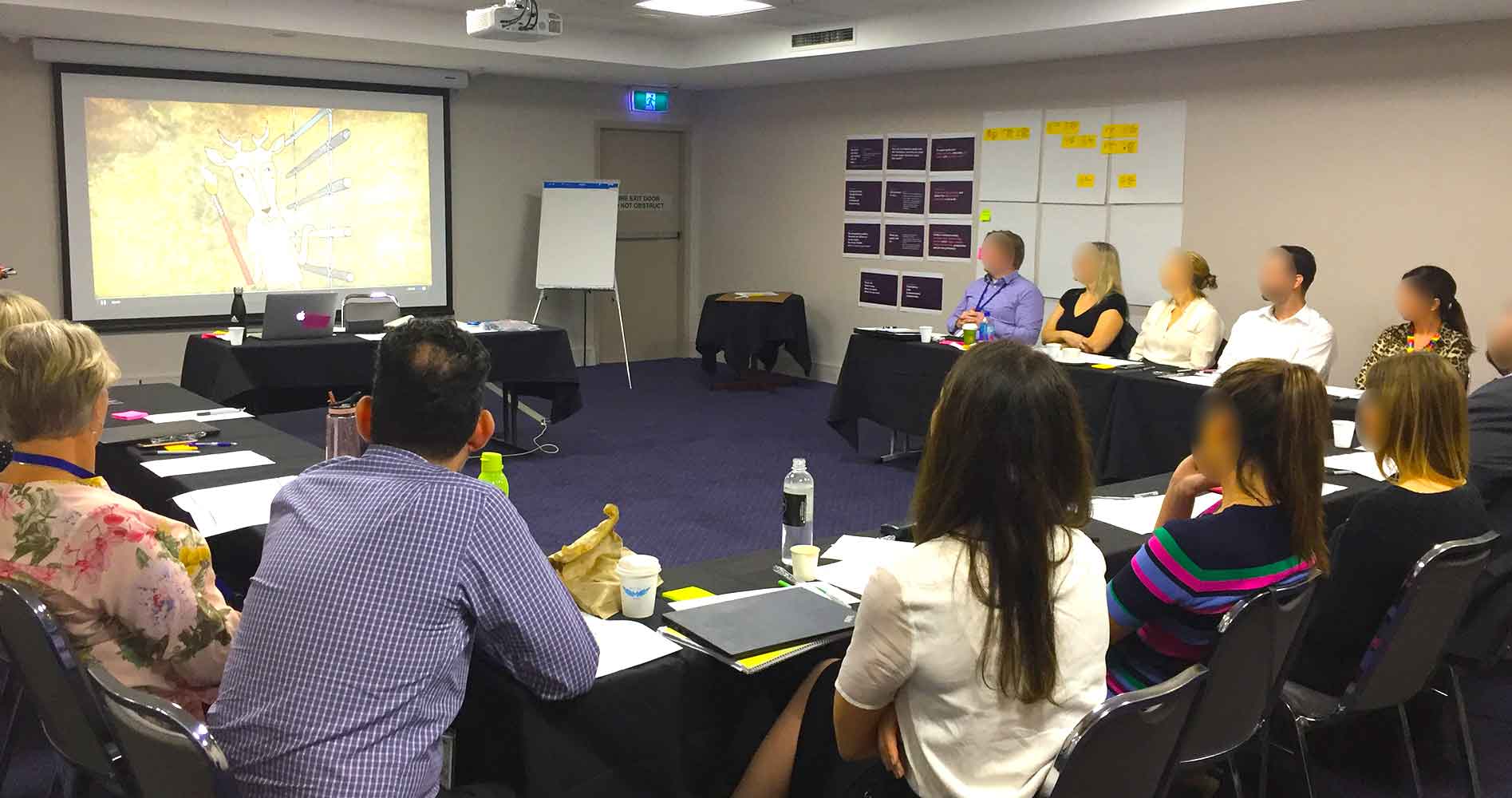
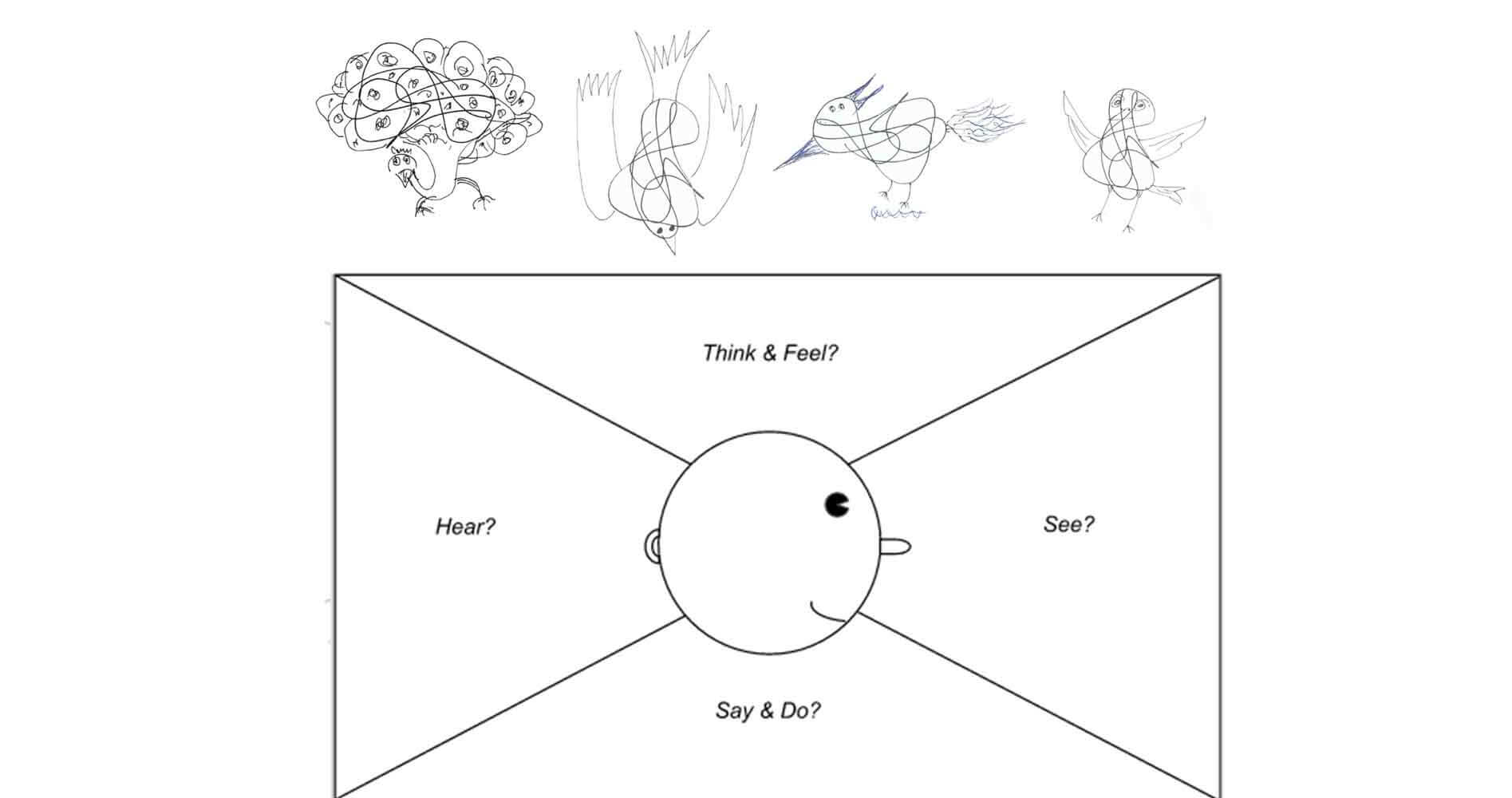
We also run an icebreaker exercise known as Squiggle birds, we gave everyone a piece of A4 paper which had a squiggle line in the middle of the page, what we wanted them to do was to turn this squiggle into a bird. To give them confidence we showed them an example of how the squiggle can be turned into a bird. We time boxed this excercise to 5 minutes and it was great seeing everyone having so much fun with it.
The point of this exercise was show them that different people have different points of view and how everyone can bring something unique to a problem.
Journeys
The offboarding process spans across four key journeys; In branch, call centre, app / online and outbound calls. To understand what is and what isn't working throughout each of these journeys we went through them step by step with the help of the key stakeholders from each of the departments.

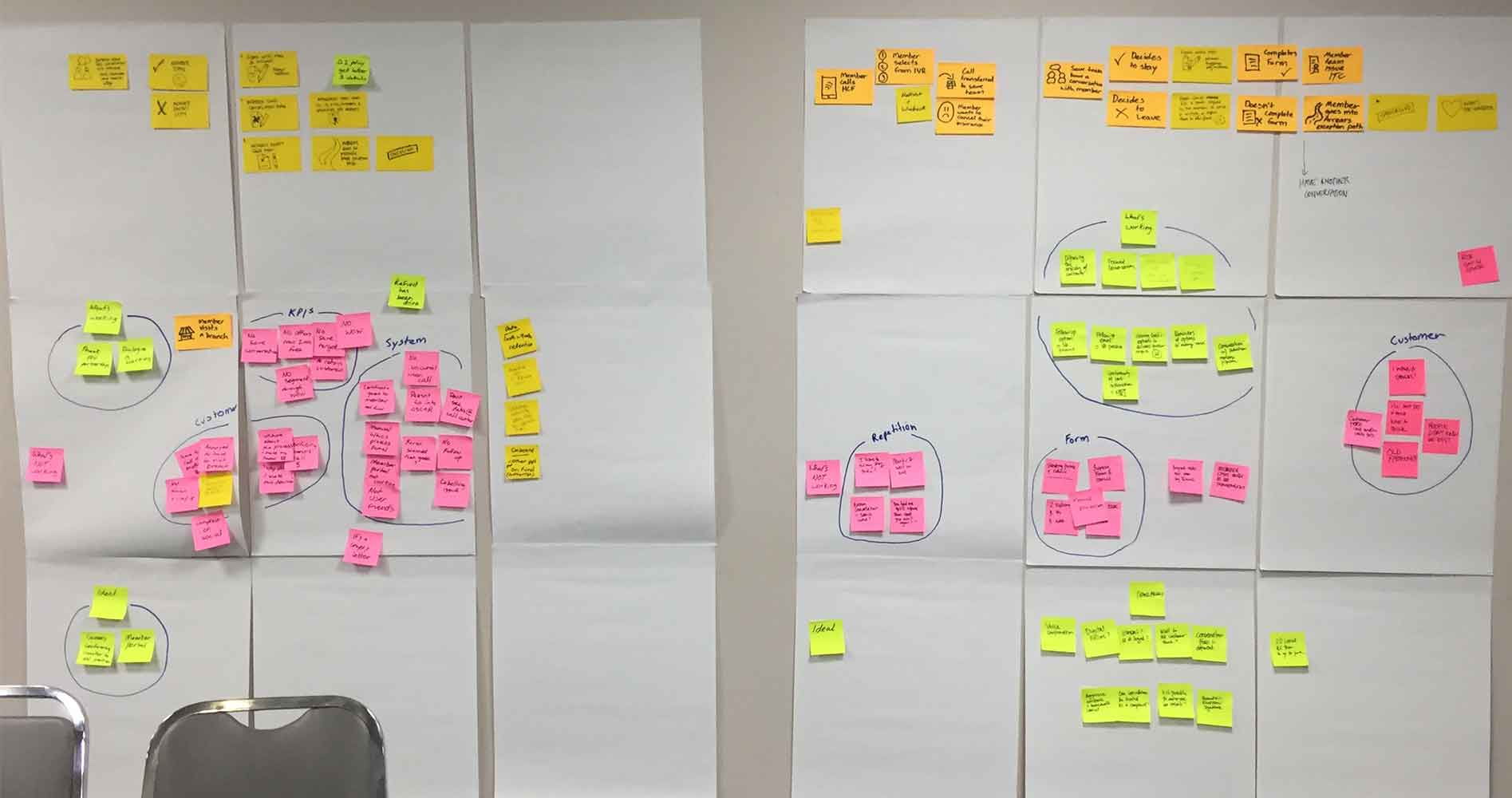
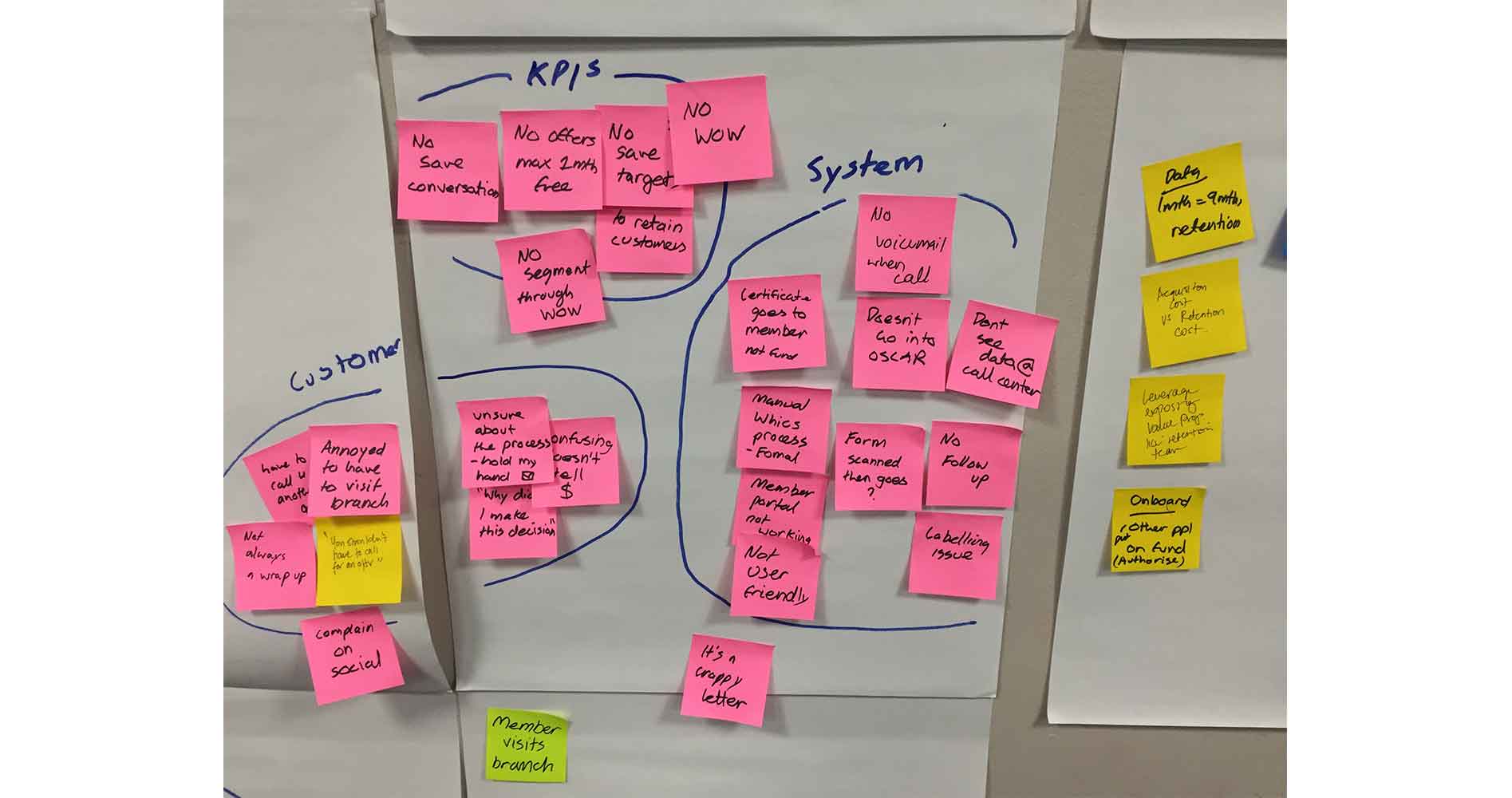
By running through each of the four journeys with the key stakeholders in each of their respective departments we had a better understanding of how the end to end journey looked and uncovering where some key moments in these journeys took place. From this we were able to define three key moments that were present in all of the journeys:
- When a member is undecided on wanting to cancel their private health cover
- When a member has already cancelled their private health cover by going to a competitor
- When a member was thinking of leaving their private health cover and was detained by a member of the Save team
create task flows for each to get a high level understanding of what the member experiences at each touch point with the healthcare provider.
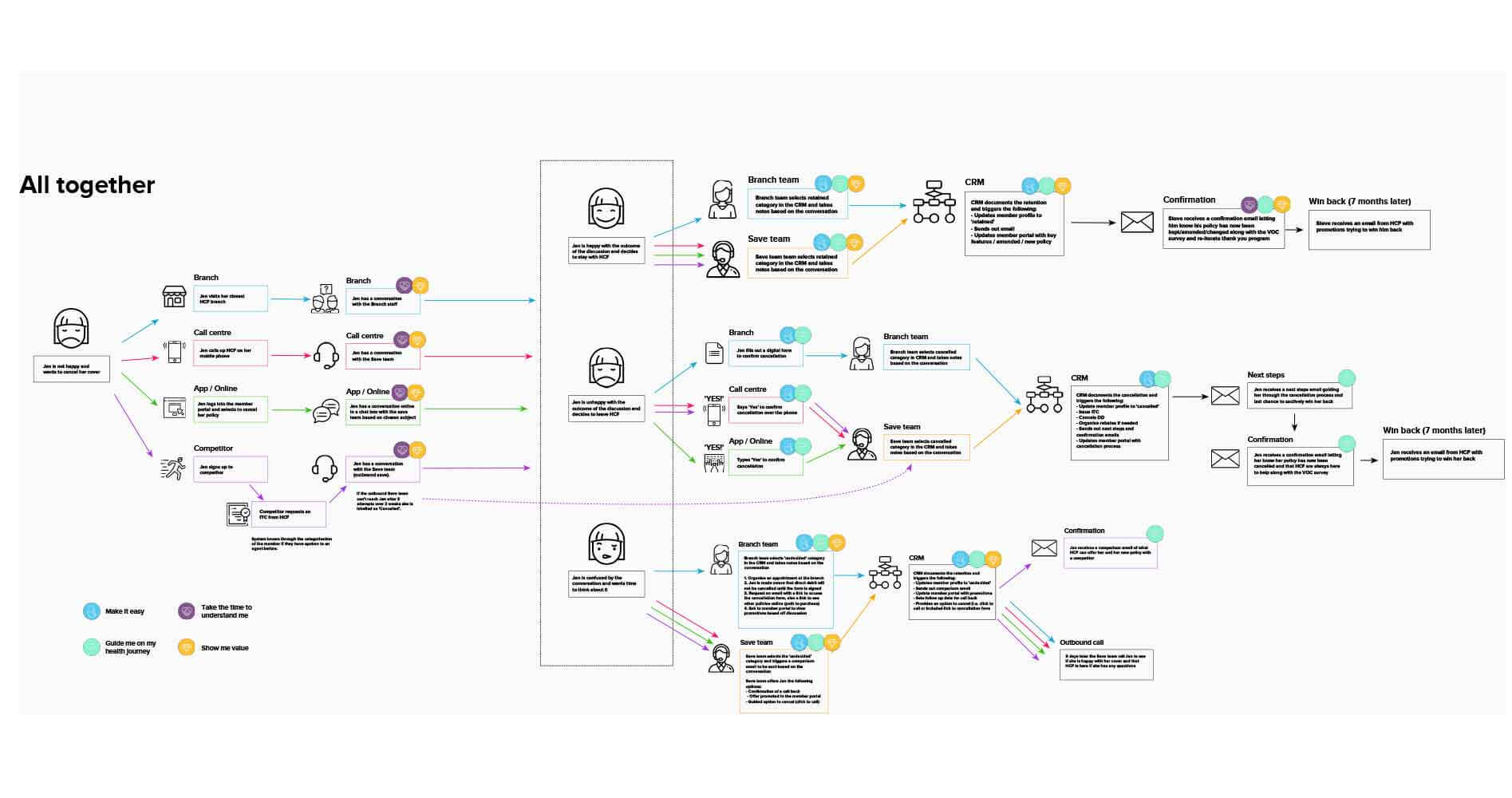
We used the key decision points in these taskflows as a skeleton of how we would improve the offboarding service. We collated all the notes and findings from the alignment workshop and sat down with the technical team to understand how the processes and systems worked together to make this high level process a reality. With the technical team's help we were able to map out current state service blueprints.
Current state service blueprints
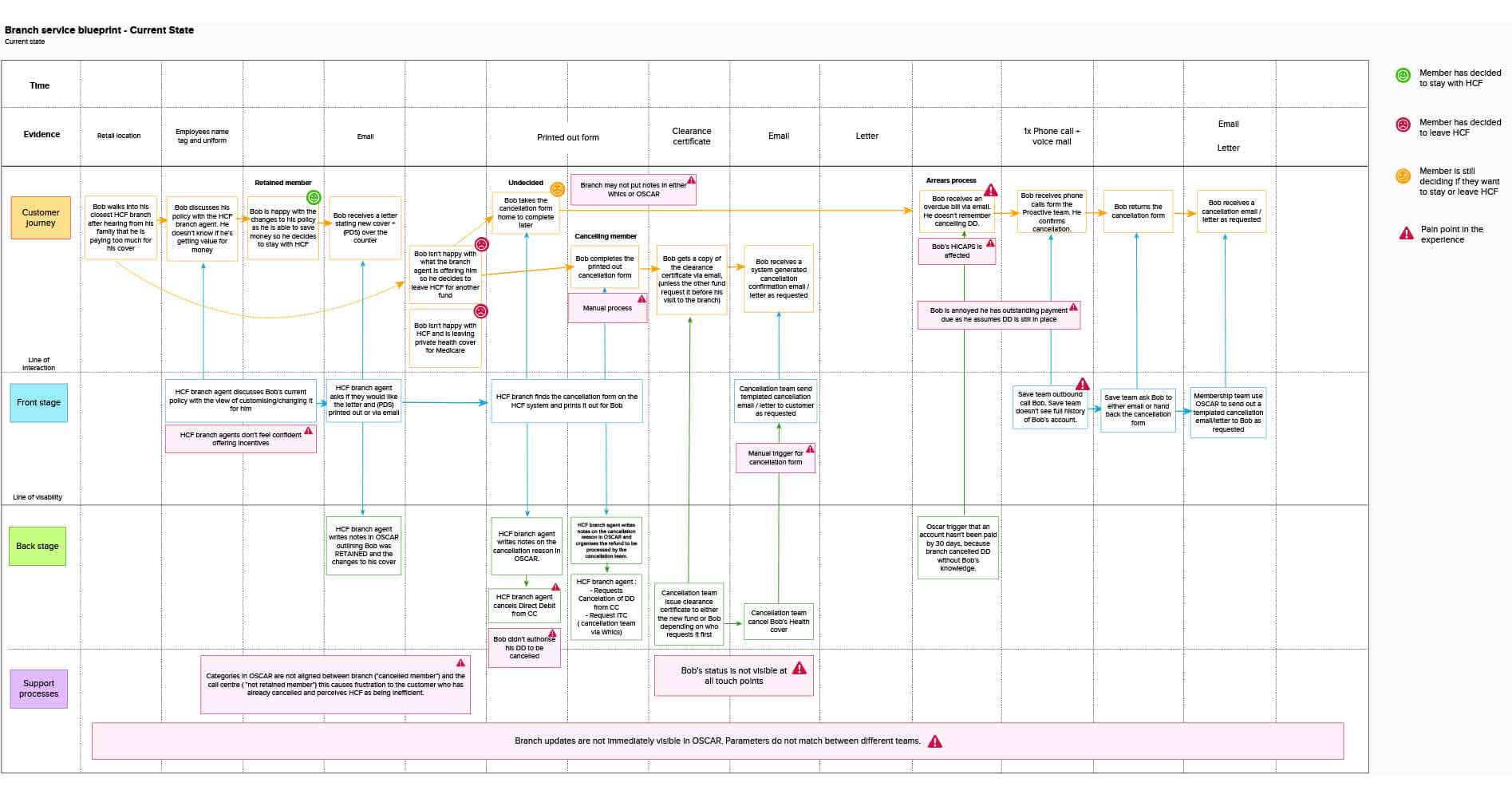
In Branch current state
Bob is a private healthcare member, he walks into a branch as he isn’t sure if he is getting value for money as he has spoken to friends and family about what they’re paying, after this point there are three different scenarios:
Decides to cancel
Bob isn’t happy with what the branch agents is offering him so he decides to leave for another healthcare provider. He then completes the printed out cancellation form, days later he receives a clearance certificate which he can take to a new provider (unless another provider has already requested one before he visited the branch). A few days later he receives an email cancellation confirmation.
Undecided
Bob takes the printed out cancellation form home to complete later. Several days later he receives an overdue bill notice via email, he doesn’t remember cancelling his direct debit he then receives a voicemail from the proactive team asking him to pay his outstanding bill.
Bob is really frustrated at this point and rings the healthcare provider up saying he wants to cancel, he is then told he has to print out a cancellation form and scan it back to them.
He remembers the cancellation form he received from the branch and returns it to them. Bob then receives a cancellation email and letter as requested.
Retained
Bob is happy with the conversation at the branch and sees what value he is getting from his policy, he is happy to make a few changes to his policy and decides to stay with his current private healthcare provider. Bob receives a new cover (PDS) over the counter.
Painpoints
- Branch agents do not feel confident offering incentives, also they don’t have retention KPIs
- Systems don’t have the same categorisation across different touch points
- Cancellation forms a manual process
- Notes are not always documents about the member in the system
- Bob’s HICAPS is affect when he is undecided
- Bob didn’t authorise direct debit to be cancelled
- Bob’s status isn’t visible at all touchpoint
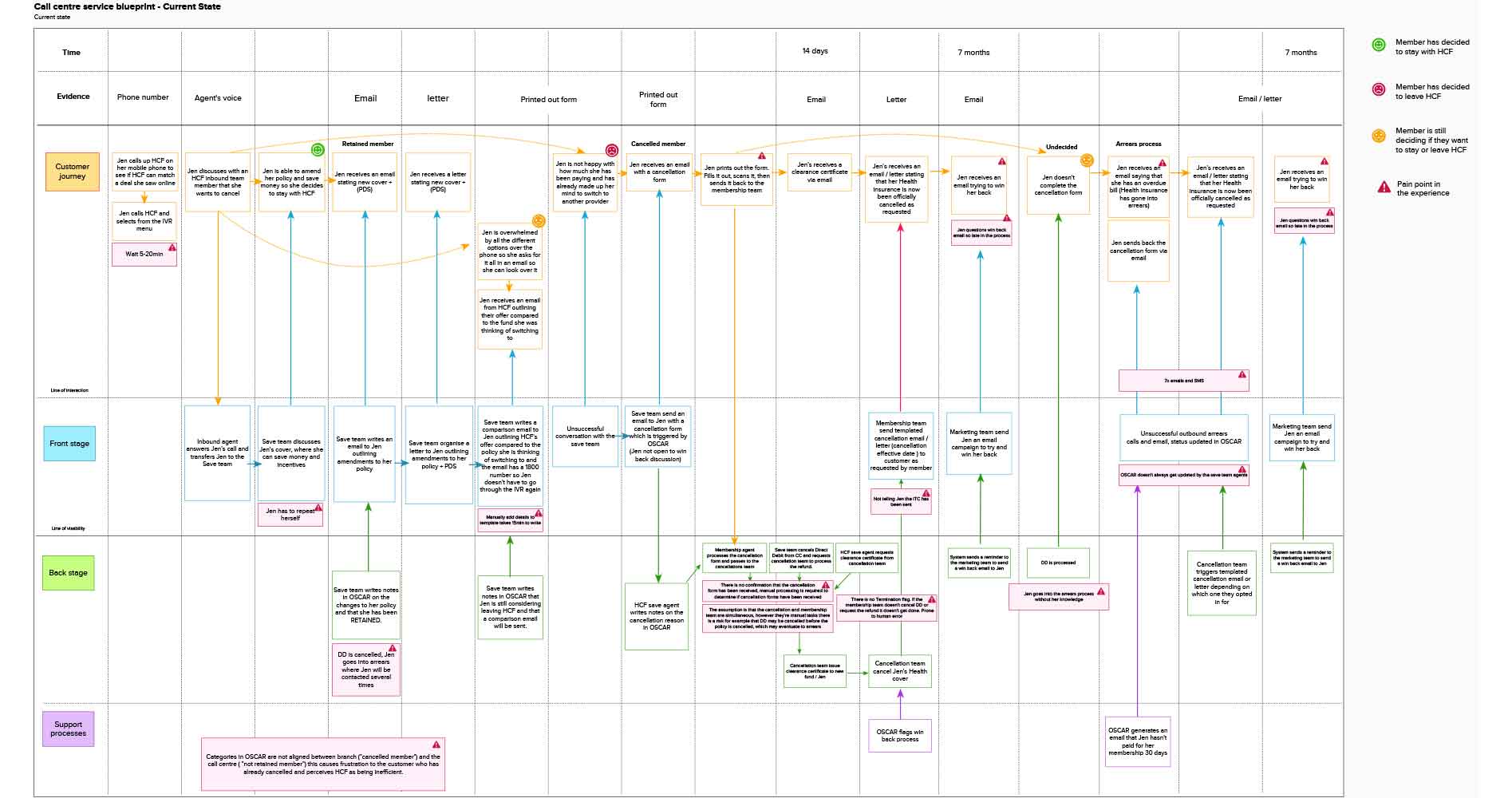
Call centre current state
Jen calls up her private healthcare provider on her mobile to see if they can match a deal she saw online. Jen discusses with the agent that she wants to cancel to see if she can get a better deal, after this point there are three different scenarios:
Decides to cancel
Jen is not happy with how much she is paying and isn’t happy with the offer the agent on the phone is giving her so she has made up her mind that she will take up the offer she saw online.
She receives an email with the cancellation form attached, which she then has to print out, fill it out, scan it in and then email it back to her provider. She then receives a clearance certificate via email 14 days later. Two days after leaving her healthcare provider she then receives an email confirming that she has cancelled.
Several months have gone by and she receives an email out of the blue trying to win her back to the provider, she feel this is little too late and doesn’t respond to the email.
Undecided
Jen is then presented with multiple options over the phone on what amendments she can make to her policy to save money, this is overwhelming the amount of different options and price points that it is hard to remember them all so she asks if its can all be sent to her via email.
Jen shortly after receives an email comparing all of the options and prices that she would need to pay against the plan she was thinking of switching too.
Retained
Jen speaks with an agent over the phone and they come to a conclusion of how she can update her policy to save money. This makes her very happy so she decides to stay with her current provider.
Pain points
- She has to wait on the phone up to 20minutes to be directed to the right person
- Jen has to repeat herself when she is directed to the save team
- Save agent has to manually write up the comparison email which can take up to 15 minutes to write
- There are no termination flags in the system is she decided to leave
- Jen feels that the provider doesn’t care about her when she receives a wingback email several months later
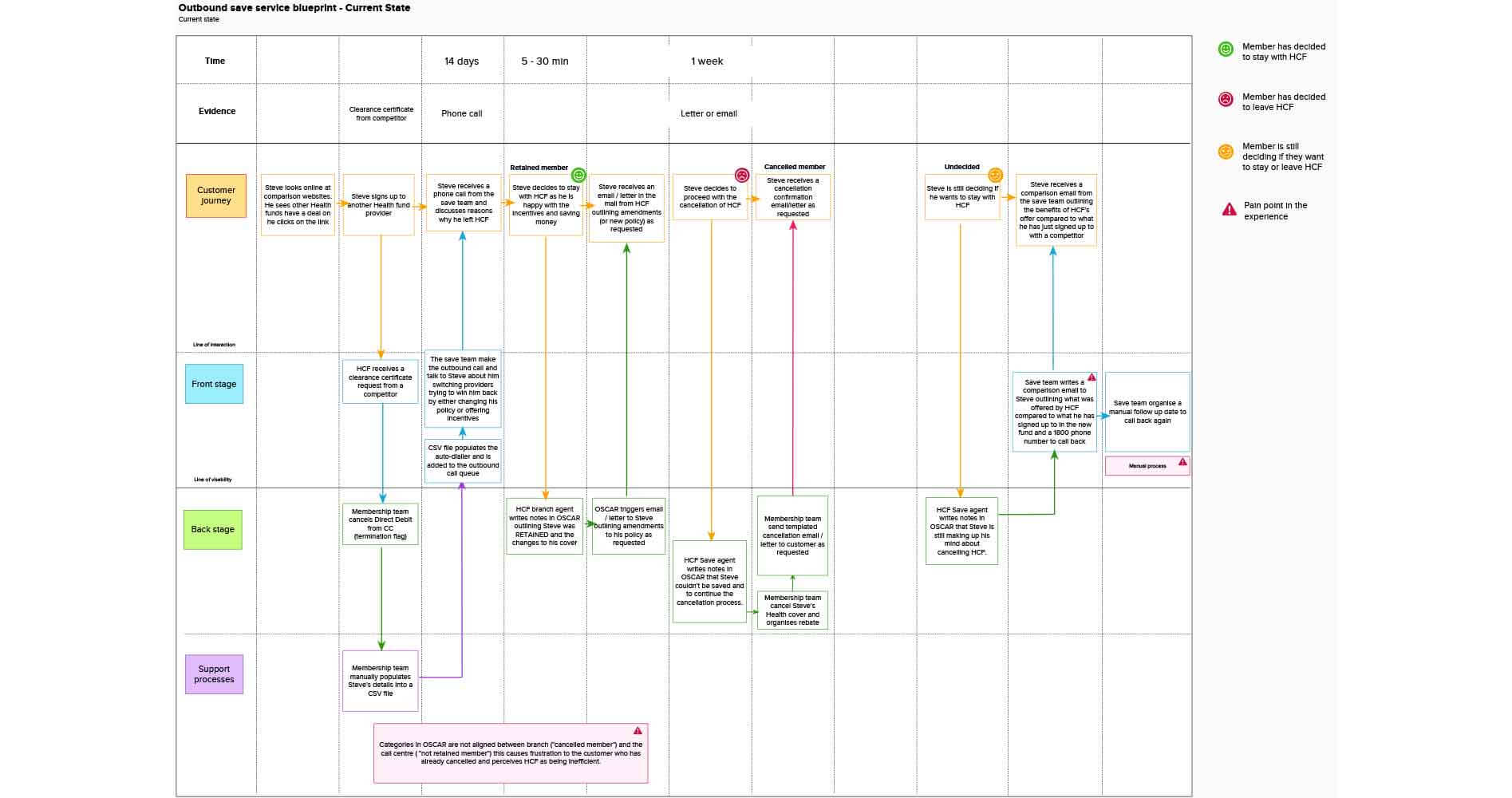
Outbound Save current state
Steve looks online at comparison websites to see if he can save money on his private healthcare. He sees another health fund has a deal on so he clicks on the link, Steve then signs up to this new health fund provider. Few days later Steve receives a phone call from the save team to discuss reasons why he left, form here there are now three paths:
Decides to proceed with new provider
Steve talks to the agent over the phone, however his mind is made up and he can’t be persuaded to stay. A few days later he receives a cancellation confirmation email
Decides to stay with old provider
Steve is impressed with the incentive the agent has given him, so he decides to stay with his original healthcare provider and is told they can stop the transfer of him going to a new provider.
Undecided
Steve listens to the agent and tells them that he will think about the offer that they have presented to him. He then receives a comparison email stating what they had discussed over the phone.
Pain points
- Comparison email is written manually by http save agent
- Categories of member’s status do not align across all touch points
Principals
Based on the current state of each of the offboarding processes we asked the healthcare provider what would their idea scenario be and what principals do they have in pace to ensure they keep to this high ideal scenario. The healthcare provider had multiple prinicpals throughout the organisation so they decided to create new ones and make those the source of truth.
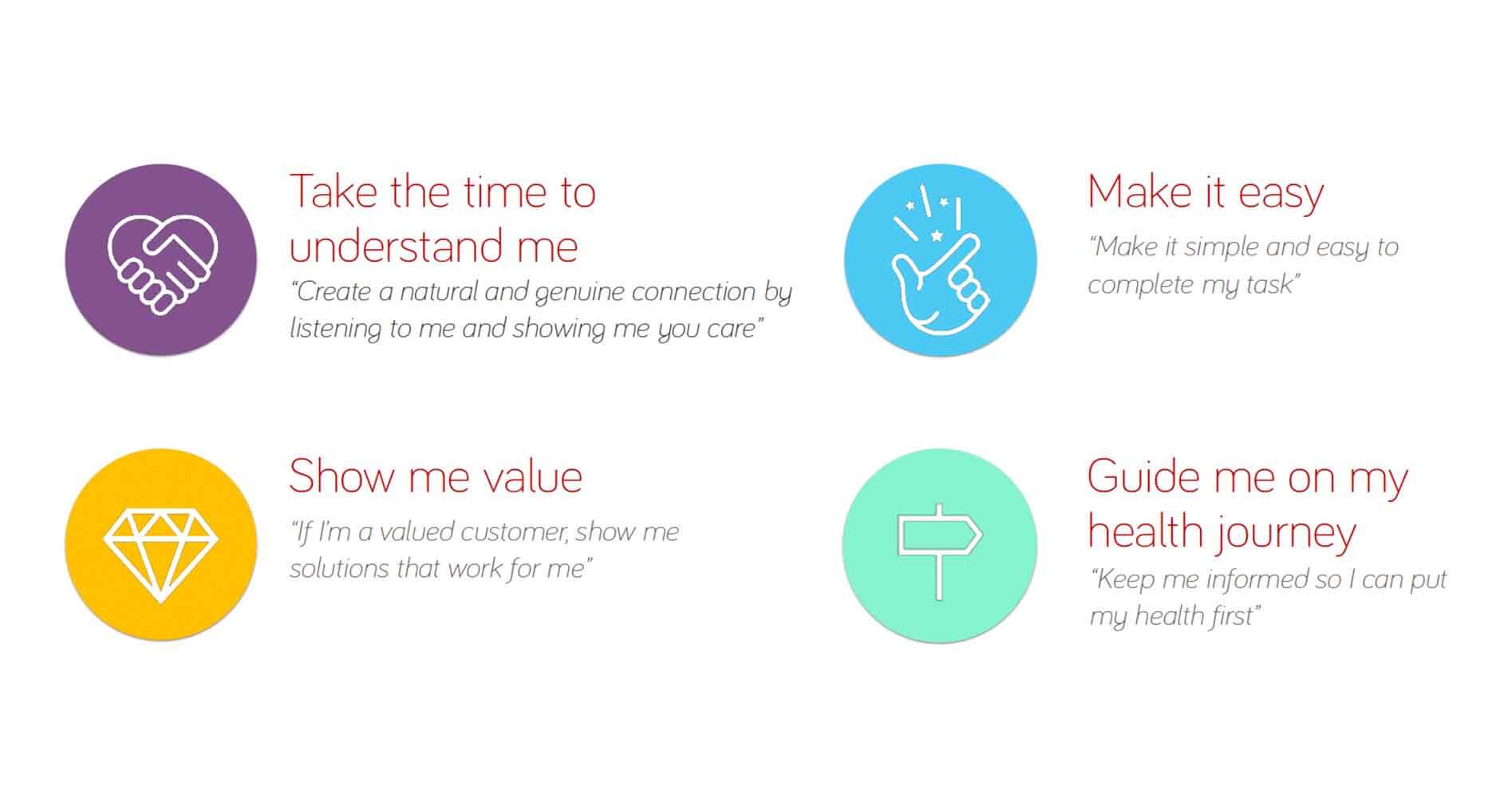
The four service principals are:
- Take time to understand me
- Show me value
- Make it easy
- Guide me on my health journey
Take the time to understand me
“Create a natural and genuine connection by listening to me and showing me you care”
- Show that you care enough about your customers to take the time to listen and respond in a way they
- Demonstrate respect for a customer’s choice. Let them leave us feeling comfortable. Embed a positive perception of HCF which may encourage them come back to us in the future.
- Demonstrate respect for a customer’s choice. Let them leave us feeling comfortable. Embed a positive perception of HCF which may encourage them come back to us in the future.
“Don’t make me feel uncomfortable about my decision, help me understand my choices”
Show me value
If I’m a valued customer, show me solutions that work for me”
- Often customer’s struggle to understand what they are paying for. Always look for ways to reinforce value to customers’, reminding them of why they chose HCF. Help them navigate PHI and make informed decisions to stay.
“Give me a reason to stay”
Make it easy
Make it simple and easy to complete my task”
- Create a simple process by delivering a unified experience through all customer touchpoints; aligning channel processes and communications.
- Consistently seek feedback from your customers to make continuous improvement to your services. Demonstrate that their experiences are important to you.
“Leaving should be as easy as signing up, if not easier”
Guide me on my health journey
“Keep me informed so I can put my health first”
- Be clear with customers on the status of their policy – whether they need to act or not. Update members on key stages or timeframes in the process. Providing transparency about the process gives customers a greater sense of control.
“Reassure me that you have completed my request to cancel”
Future state service blueprints
With the service principals provided guiding us, we started creating what would the service future state look like
Branch ideal state
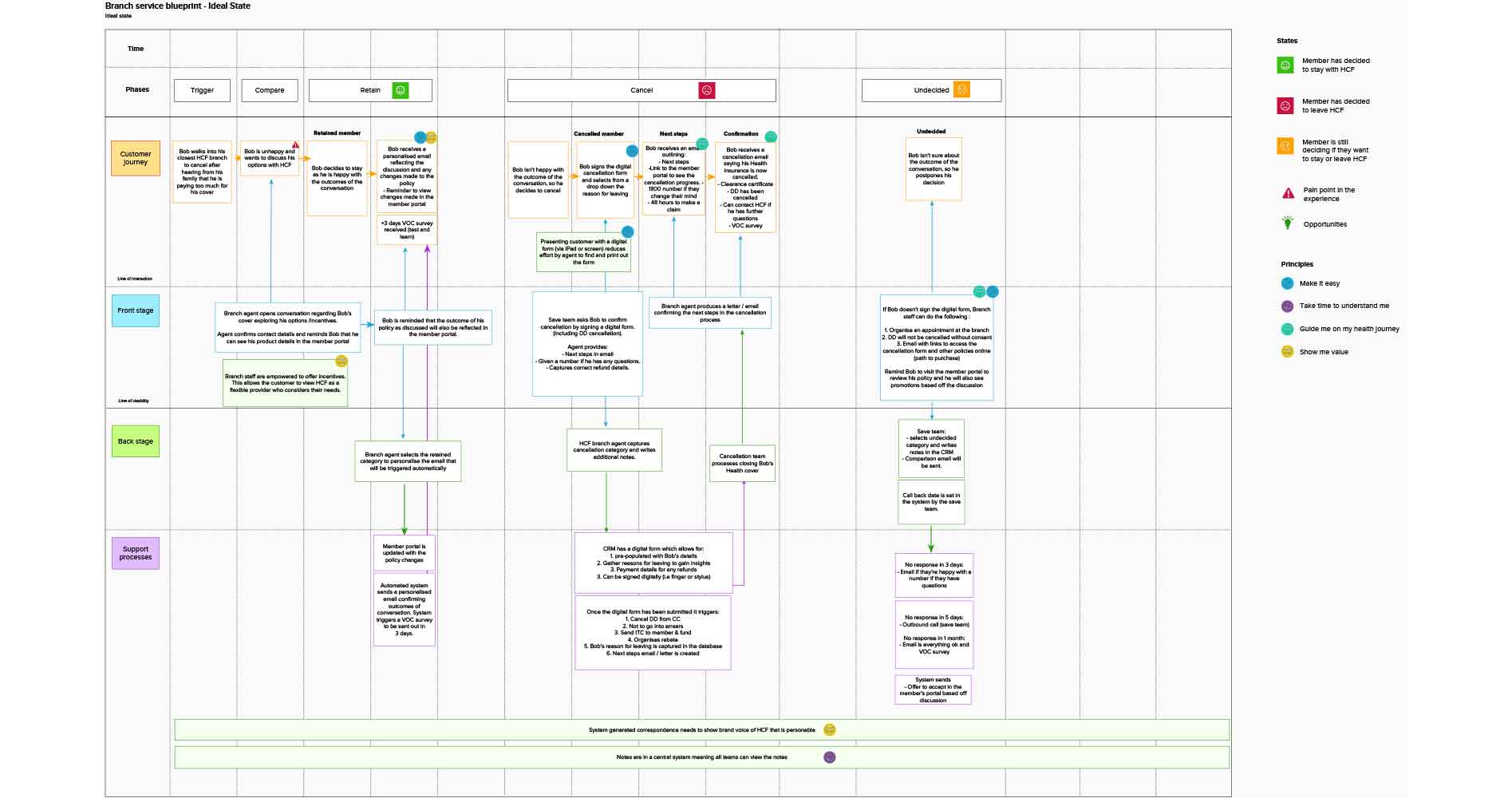
Ammendments
- Branch staff are empowered to offer incentives to retain their members
- System generated correspondence has the same tone of voice as all other communications
- Agents write notes on the member’s status in a centralised CRM system
- Presenting customer with a digital form (via iPad or screen) reduces effort by agent to find and print out the form
- Direct debit will not be cancelled without the member’s consent
- Appointments will be made at the branch at a later date for the undecided members
Call centre ideal state
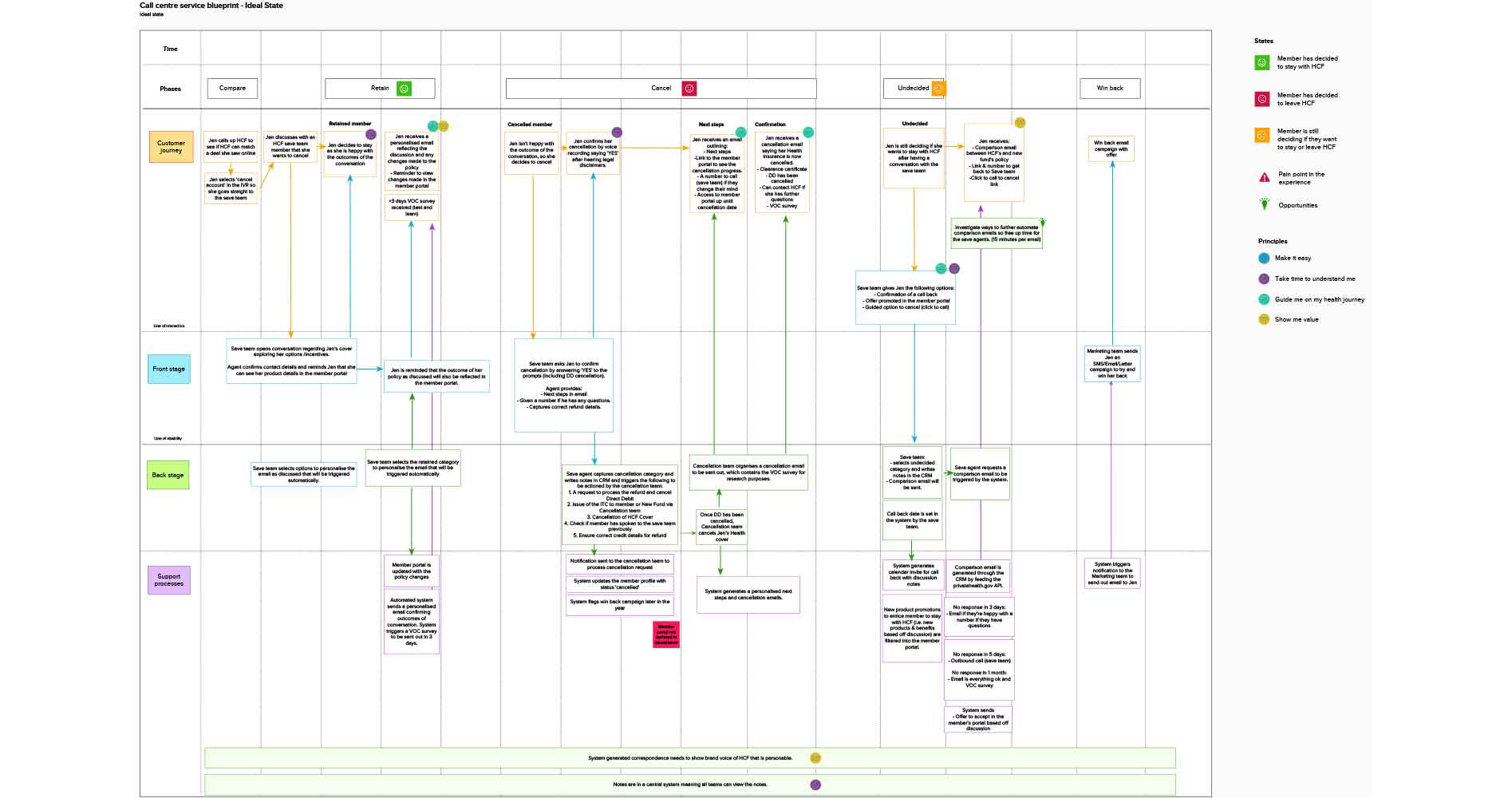
Ammendments
- Comparison emails are easier to compose via smart filters
- Categories are consistent across all touch points
- Use of voice, saying ‘yes’ rather than filling out form to cancel
- System generated correspondence has the same tone of voice as all other communications
Outbound save ideal state
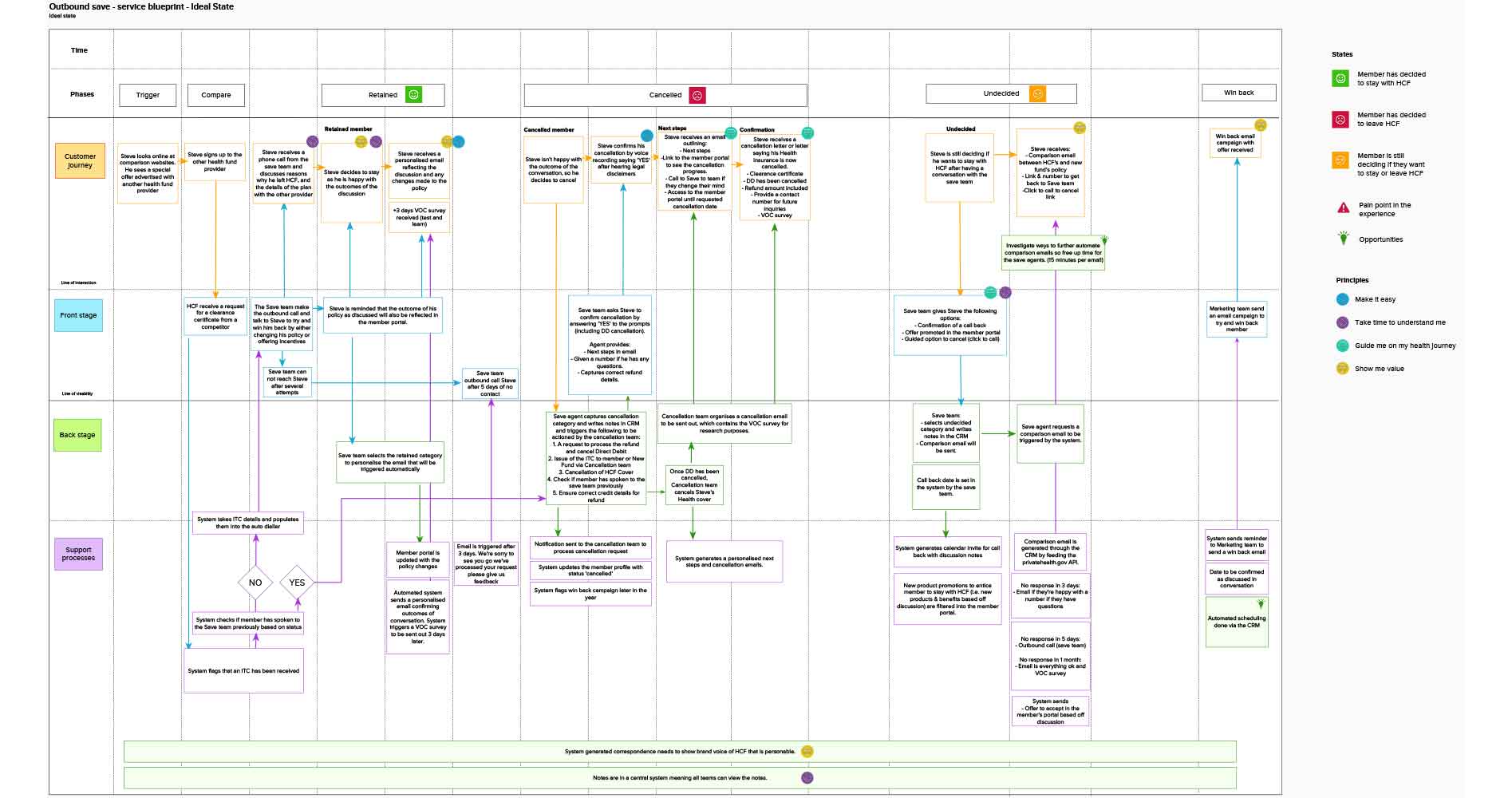
Ammendments
- Automated systems check if members have requested a transfer to a new fund
- Direct debit will not be cancelled without the member’s consent
- Use of voice for retained saying ‘yes’ rather than filling out form
- Use of member’s portal to track the cancellation process
- System generated correspondence has the same tone of voice as all other communications
Research themes
Based off the research conducted by contextual inquiries at the call centre, listening to members and staff's painpoints first hand and analysing the process flows we saw trends in the data, we took these trends and turned them into themes of how the offboarding experience can reach it's ideal state at every touch point.
From these themes we built a service pyramid showing three building blocks on how to achieve an optimised. These three building blocks are:
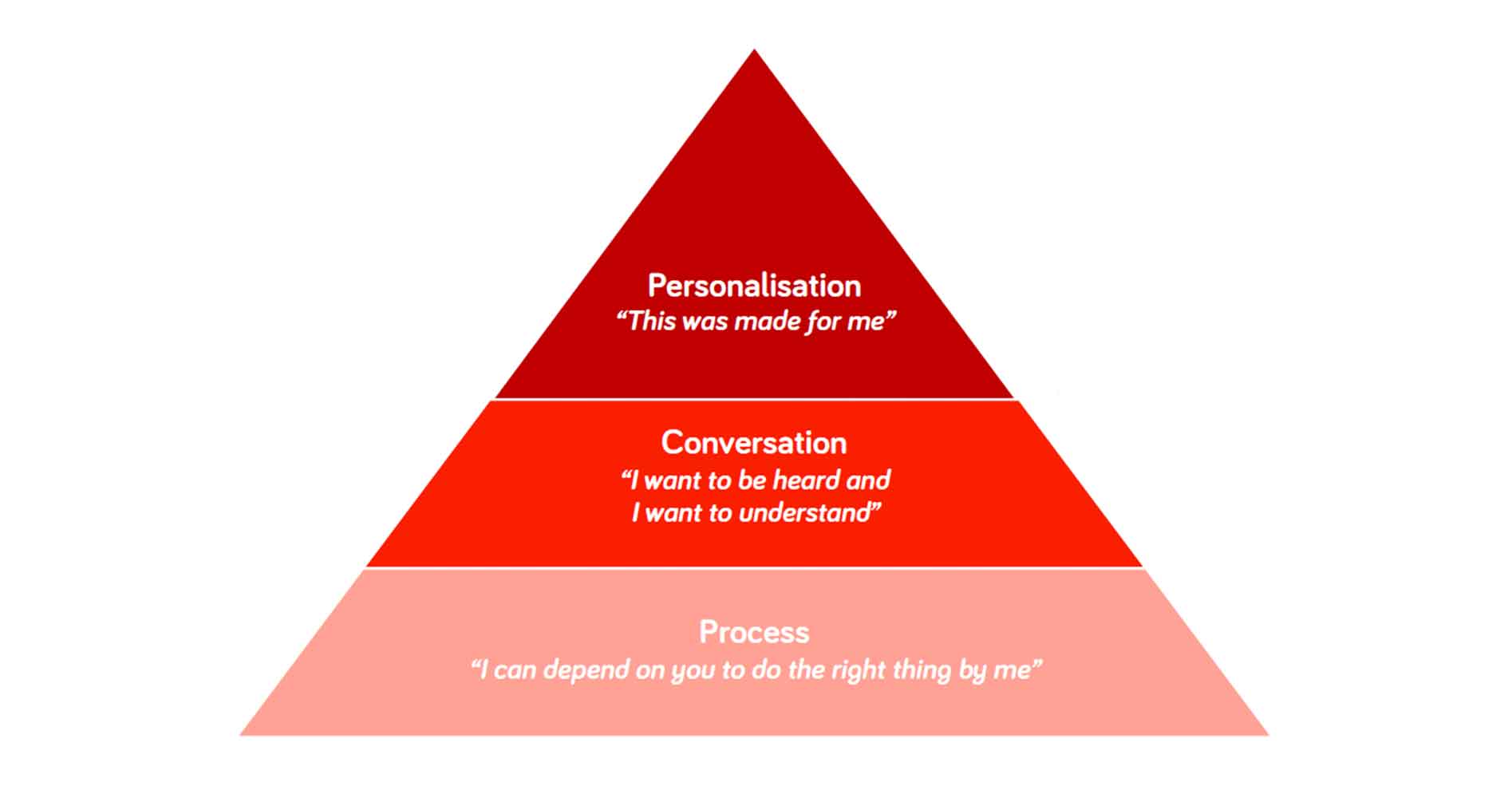
Process
Focus on a central CRM to ensure:
- Reducing members going into the arrears by creating process interdependencies
- Implement digital processes to do the heavy lifting to spend more time understanding our members
Conversation
Design for conversations so that:
- Better conversations means better understanding of members
- Consistent tone of voice in all communications
- Optimise the members portal and app to encourage conversation
Personalisation
Smarter use of customer data
- Allows for a single view of the customer for a more personalised service.
Results
Alignment workshop - create a shared understanding of empathy as well as outline each journey's pain points for each department.
Current state service blue prints - Understanding what the pain points are with members, staff and processes.
Principals - Work with the organisations principals to set future state service blueprints.
Service strategy pyramid - Framework on how the organisation can reach its goal of providing a more personalised service.